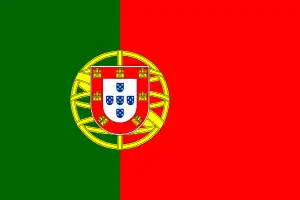Luso-Africans
Luso-Africans are people of mixed Portuguese and African ancestry who speak Portuguese.[1] The vast majority of Luso-Africans live in former Portuguese Africa, now referred to as Lusophone Africa, comprising the modern countries of Angola, Guinea-Bissau, Cape Verde, Mozambique, São Tomé and Príncipe, and Equatorial Guinea. A sizable number of Luso-Africans have also settled in Portugal where they form a racial minority. This ethnic identity arose from the sixteenth century as primarily male Portuguese settlers, often Lançados, settled in various parts of Africa, often marrying African women.[2]
In the fifteenth and sixteenth century, Portuguese traders settled in Cape Verde and along the West African coast from Senegal to Sierra Leone.[3][4] Descendants of these traders and of local African women formed the nucleus of a Luso-African community that soon developed a distinctive culture, joining elements of European and local African culture. These Luso-Africans, or "Portuguese" as they called themselves, were commercial middlemen, distinguished by their language (Portuguese and later Crioulo), architecture and Christian religion. As each of these characteristics could be shared by members of adjacent African communities, identity transformations in both directions were relatively common. "Portuguese" identity remained both fluid and contextually defined through the seventeenth century. During the eighteenth and nineteenth century, however, 'Portuguese' were drawn increasingly into a European discourse on identity, one based upon a priori characteristics, primarily skin color. Forced to respond to this imposed identity, Luso-Africans continued to maintain that they were "Portuguese"; however, they also now began to define themselves negatively by reference to what they were not.
See also
References
- Newson, Linda A. (March 2012). "Africans and Luso-Africans in the Portuguese Slave Trade on the Upper Guinea Coast in the Early Seventeenth Century". The Journal of African History. 53 (1): 1–24. doi:10.1017/S0021853712000011. ISSN 1469-5138. S2CID 162916419.
- Newitt, Malyn. ""Portuguese" Style and Luso-African Identity: Precolonial Senegambia, Sixteenth-Nineteenth Centuries". Leeds University Centre for African Studies. Leeds University. Retrieved 18 March 2016.
- Mark, Peter (July 1997). "THE EVOLUTION OF 'PORTUGUESE' IDENTITY: LUSO-AFRICANS ON THE UPPER GUINEA COAST FROM THE SIXTEENTH TO THE EARLY NINETEENTH CENTURY". The Journal of African History. 40 (2): 173–191. doi:10.1017/S0021853799007422. ISSN 1469-5138. PMID 21970008. S2CID 161084701.
- Hanson, John H. (2004). ""Portuguese" Style and Luso-African Identity: Precolonial Senegambia, Sixteenth-Nineteenth Centuries (review)". Journal of Interdisciplinary History. 35 (1): 173–174. doi:10.1162/002219504323091667. ISSN 1530-9169. S2CID 142577893.
Bibliography
- Gilbert, E. & Reynolds, J.T. (2008). Africa in World History: From Prehistory to the Present. New Jersey: Pearson Prentice Hall.
